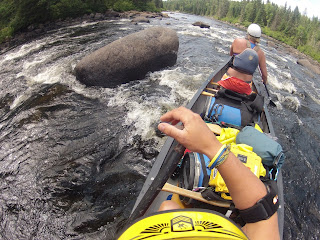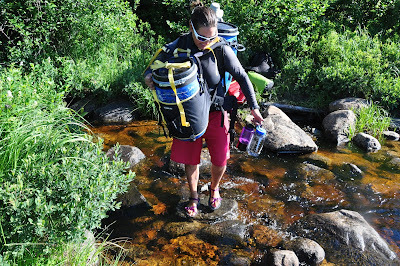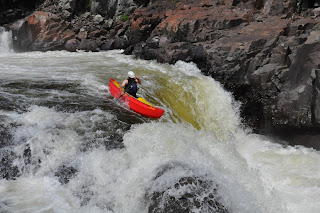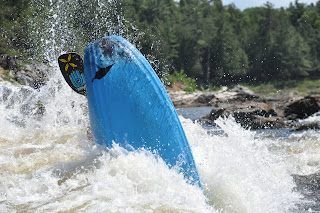Whitewater Canoe Tripping: The Great Teacher
Katie Quinn
Katie Quinn
Adventure and outdoor pursuits are a huge part of who I am. My life’s story to date has been greatly influenced by the amazing people, places and experiences I am connected with through continually seeking out opportunities to experience the simple pleasures that life holds. By simple pleasures, I am referring to small miracles and secrets that nature possesses and shares, the amazing subtleties that are revealed to those who are aware and in tune with her rhythms.
Whitewater, in particular holds a sacred place in my heart. Whitewater kayaking unequivocally is my passion. It satisfies my need for adrenaline, provides focus, keeps me healthy, strong, and offers freedom from living an ordinary life. Whitewater canoeing, on the other hand, at one time served as a close second to kayaking. This entry is about all that whitewater canoeing has to teach and how it has become increasingly more important to me. When I reflect upon all that I have learned from tripping, I am astounded as there is so much to give and gain. For this reason, I have cast a wide net for my topic base in this reflection.
My goal is two-fold, to capture through words and images a glimpse of what it is about whitewater tripping that makes it so special and unique and also that I may inspire those who are considering canoe tripping and provoke thought and consideration in those who’ve already been enchanted by the “Tripping Bug”. While I realize that each paddler has their own perspective on this topic, these are my thoughts on the experience.
When one agrees to go on a whitewater Canoe Trip, they are essentially giving and committing themselves to the trip for whatever the duration, whether it is for 2, 4, 7, 12 or more days. During this time, the days and nights are shared, they are no longer entirely your own. Essentially all decisions and actions are for the benefit or consideration of the greater group. You are becoming part of a team in the truest sense. Each player in the group might have slightly different goals and visions about what they want out of the experience. However, the same basic goal of getting down the river successfully and enjoyably is at the forefront.
In planning great whitewater trips, the topics that initially surface are: the choice of a great river, assembling a solid group, good food, appropriate gear, and weather conditions. These are the most talked about aspects at the surface, as they are logistical necessities. While these aspects are important, there is so much more involved in the experience that it is hard to know where the influence of the experience begins and ends.
Starting with the obvious highlights of the trip, the river itself is really the main event. Hopefully the river you’ve selected is easily accessible, or perhaps there is a nostalgic train, shuttle or floatplane put-in and most critically that it meet the skill set of the group. Ideally, it is gorgeous, challenging, has established campsites and is raw and largely uninhabited other than by wildlife. In addition, having water levels on your side is a huge bonus as you typically select and book these trips months in advance of the actual trip.
A good menu is paramount and really quite easy to make happen. My theory is that “you never know when your last meal will be, so they’d better all be good ones” totally applies. This process simply requires some strategic planning, especially for menus beyond day three when food has gone without refrigeration.
Weather will be what it will be… and there’s nothing you can do about it. Gearing up appropriately can save the trip should poor weather set in. Good gear can make or break a trip…spanning from just about every item you carry in your boat including the boat itself, paddle, helmet, footwear, lifejacket, throwbags, cooking utensils, water purification, clothing layers, sleeping bags and mats and so much more.
The group dynamic is one of the most critical and most difficult elements to predict and yet, most important factor in the over all success of a trip. Selecting a winning cast of characters is a shot in the night at best. It’s been my observation however, that on many trips you’ll find yourself in tight quarters with people who you might not necessarily gravitate toward and it is pretty incredible to see how the collection of tiny moments with many people over the course of seven days accumulate and become very meaningful in the end.
With the more obvious factors of tripping addressed, I want to dive into aspects that factor in to just about every day and while they may seem small, actually have great significance to the overall experience.
When tripping, (assuming you are in tandem canoes) you and your partner paddle down rapids with boats filled with precious cargo that may prove to be critical to your survival. (Items such as warm/dry clothes, sleeping bags, tents, food…and arguably alcohol.) At each formidable rapid, teams must consider whether to run full of gear, to portage gear and run the canoes empty, line the boats down or portage entirely. These are important decisions as a mistake may put any of these items, the actual canoe, or even paddlers in peril. At any major rapid on a 7 boat trip, each team may choose any combination of the options listed above. Careful consideration of many factors goes into arriving at a plan to reach the bottom of the rapid. Risk assessment, choosing the line, a shared vision between the tandem team is essential. This process ought not push or pull either team member; they need to walk the journey in solidarity together. Consideration to the larger group needs to factor in as well, so that if things go wrong, how will this impact the rest of the group? Canoe partners develop a special connection. Ideally, they celebrate the tough rapids that they’ve decided to tackle, and take it in stride when things don’t go as well as planned. It truly is a dance shared between the team and the river.
The late great Canadian film maker Lynn Clark worded this in reference to whitewater kayaking so well “it is about you and the medium (rock or water or snow or ice) nothing else, so the success is yours alone, the misses are also yours alone, it is very liberating and invigorating, and you can’t help but grow, as long as you are sensitive to this and aware of the rules, and as long as you are humble enough to learn what it being taught.”
Bonding of the tandem team is one of the most powerful aspects of tripping. Celebrating successes that I’ve described above are amazing and serve as an adhesive force. The tandem bond goes beyond shooting a technical rapid in textbook fashion. It’s about spending 7 hours of your day in a canoe with that person, just the two of you. Its how you handle a nasty relentless head wind; it’s what you find to talk about in the hours of flat water paddling. It’s about the confidence that you have in that person to do what needs to be done under fire in the rapids, about being a team in a potentially dangerous game. Knowing that everything that each of you does or neglects to do has an immediate impact on the other partner. What I’ve expressed here does justice to the concept of tandem bonds, yet I’m still only hitting the tip of the iceberg….the chemistry and nuances go far beyond what I have described.
While tandem bonds are arguably the most powerful on the trip, group bonds form at every turn, they develop when helping someone out on a portage, fishing a teammate out of the river, sharing your last precious drops of wine, that person who wakes up early to help you with breakfast, shenanigans and silliness of the jokers of the group, sharing a rock or a log and a moment as the sun goes down. Through this process, as we come to know one another our gifts and talents surface, roles within the group develop and are reinforced.
Many of the most magical moments on trip are the small things, moments and memories that linger well past the last day of the trip. These often come in the form of life’s simple pleasures that I referred to in the opening. Moments such as witnessing the power of the river, sunsets, sunrises, nighttime in a forest, kind words, a much needed back rub, group bathing with 12 of your “closest” buddies, finding ways to help one another, the exhaustion and satisfaction that comes from a full day of breaking camp, paddling, portaging, food preparation, and bedding down for another night, and looking forward to all that the next day brings.
Campfires alone deserve acknowledgement. They possess warmth and an invitation to unite and draw near. Many true moments are shared in its glow. If campfires could talk, the stories they could tell.
When thinking of ideal camping weather, sunny blue skies and starry nights are what first come to mind. However, some of the most powerful memories when camping are those of stormy weather when nature is either ornery or plain old raging. On a typical rainy day, humans tend to run in between buildings and vehicles to avoid getting wet. This isn’t an option when the skies open up and shower down on mile 7 of a 20 mile day. There is an incredible beauty in getting soaked when the rain comes down sideways and droplets are exploding off the surface of the water. It’s very liberating at times to surrender to Nature and simply be at one with the mood she’s in. Grey skies, slate water and water dripping from the trees following the rain offer a whole other beautiful mood to the natural surroundings.
In discussing poor weather, I am reminded how difficult tripping is. By difficult, I mean that its very hard work. Normal everyday tasks become laborious. Making your bed becomes a task, you need to pack your sleeping bag, your sleeping mat and pack your tent, only to have to reverse the same steps 6 hours later, when setting camp. Food preparation, washing dishes, lighting a fire, transportation, and simply gathering clean water is a task. Living in the wilderness for a week is a humbling experience, it allows me to appreciate really basic things. All of a sudden it’s a big help when someone offers to pump me a litre of water.
When crisis or poor conditions happen, they are a great reminder of what’s really important in life. Vanity, rules and materialism disappear. Addressing the issue at hand becomes the focus. If hypothermia is setting in, or a canoe wraps, or someone needs help, that’s all that matters in that moment and skilled wingers will take effective action quickly to attempt to find a resolution or help if they can.
Having the equipment, knowledge, skill and proficiency to travel down whitewater sections of rivers, the very veins of the lifeblood of North America is a rite of passage. Many people will never be able to access these remote places; they may never see through their own eyes these majestic places that rivers take you. Only the eyes of those who have developed the skills necessary and take the initiative to get to these places will. I can’t help but wonder who has gone before me? Who has traveled these water ways, when and for what? In many cases, we are following footsteps of warriors, survivors, explorers, voyageurs, loggers, and adventurers.
Each time you step onto a river, and start a new adventure you can’t help but learn. Learning is implicit in each day, many times over. The lessons at the end of the day may allow you to understand the river better, perhaps you learned more about the vegetation and natural history of the area, perhaps you learned about a paddling technique, maybe it’s a lesson on tips for cooking in the outdoors, maybe you learned something new about your paddle partner, or perhaps you learned more about yourself in how you handled a difficult and stressful situation.
When I have the privilege to witness nature at its finest, I am in awe and I am genuinely grateful that I have a need to be close to her. I am grounded and rooted in her beauty, her subtleties, her strength, her recklessness, her gentle side. She is always in charge, it is solace for me….inspiring. I so often wish I could bottle moments in such spaces to share with anyone who for whatever reason has not come to know the power and awe that this side of nature possesses. Canoe Trips take me to these sacred spaces every day that I’m on trip without fail. What I’ve learned above all things, is that I have so much more to learn. If you’ve never tried whitewater tripping, you might well be missing out on some amazing opportunities in life. To all of you tripping buffs out there, feel free to top me up on all the nuances that have escaped me in this entry.
Katie Quinn
P.S. Tripping when the bugs are bad is a whole other story for another time.
















































